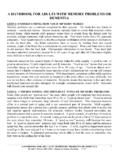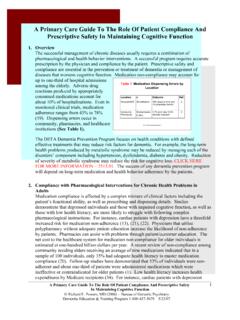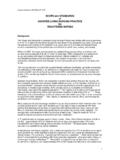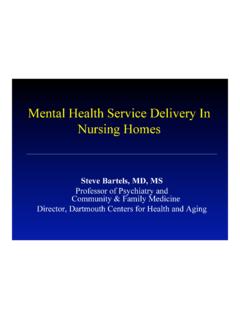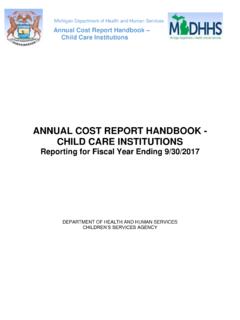Transcription of immobilization includes restraining patients to avoid ...
1 A restraint is any device or intervention that limits the freedom of a patient. The use of restraints produces a constant tension between patient rights and patient safety. The widespread use of restraints with the elderly was a major stimulus for OBRA shows that increased use of restraints increases overall expense. There is no scientific evidence that restraints will reduce the likelihood of harm to elderly patients . Since the implementation of OBRA regulations, the use of restraints has declined in nursing homes. Restraints are divided into chemical and physical. A medication becomes a restraint when the effect is sufficiently severe to limit a patient's activity -- either from sedation or drug-induced motor side effects.
2 Gait problems occur in 8% to 19% of individuals over age 65 and 38% over age year, between 30% and 60% of nursing home patients fall and 10% of those individuals will sustain a significant injury. Restraints were commonly used in medical settings and previous studies have shown that 30 - 50% o nursing home residents have been restrained and 8% to 17% of medical inpatients. Restraints are used for a variety of reasons including protecting the patient, protecting other patients , protecting the staff, staff convenience, family request and for no discernible reason. The degree of physical restraints can vary from bean bag chairs that use gravity to secure the frail elder in the recumbent position through 4-point leather restraints used for extremely agitated patients .
3 Devices such as mittens, helmets and bed rails can be considered restraints. Studies show that the degree of physical or verbal aggressions and the patient's unpleasantness predict duration of restraints. There should be a comprehensive evaluation to show the need for restraints and to ensure the least restrictive restraint is used and monitored regulations mandate that nursing homes attempt to achieve a restraint-free environment. This goal may never be met consistently in any are divided into two categories -- medical and psychiatric. The devices used to secure the patient are the same but the purposes are different.
4 Medical The Use of Restraints with Dementia PatientsDEMENTIA EDUCATION & TRAINING PROGRAM 1-800-457-56791immobilization includes restraining patients to avoid pulling endotracheal tube, IV line or falling out of bed if the patients suffer from severe dementia and gait apraxia. Psychiatric restraints include tying patients down to avoid fighting, assault or dangerous behavior. Both types of restraints require careful monitoring. Psychiatric restraints incur great scrutiny in the hospital setting. Nursing home inspectors do not always distinguish medical from psychiatric show that up to 75% of restraints are ordered by nursing staff and 15% of restraints are applied without the knowledge of responsible physicians.
5 Nurses order restraints but physicians assume responsibility for their consequences. Nurses and physicians often disagree on the reason for restraints. The decision to restrain a patient mandates a team decision that includes opinions of the physician, the nursing staff, the patient and the patient's family based on the comprehensive SYMPTOMS The use of a physical restraint is similar to that of psychotropic medications and requires a clearly defined target symptom, consideration of alternative therapies, a titrated level of restraint, assessment of side effects, consideration of restraint reduction and systematic monitoring of program symptoms for medical immobilization include documented attempts to disrupt or remove medical devices essential to patient welfare and safety.
6 Examples include removing endotracheal tubes, pulling PEG tubes etc., in a patient who is incapable of giving informed consent. Competent patients who demand the removal of medical devices have the right to discontinuation of therapy. patients who engage in dangerous behavior as a result of cognitive impairment are also candidates for restraints ( , a gait apractic patient who attempts to walk producing falls that may fracture a hip). Psychiatric immobilization requires considerably more thought and documentation of target symptoms. Common annoying behavior such as wandering, rummaging, repetitive questions, disrobing and other non-injurious activities are poorly treated by physical restraints.
7 patients who manifest aggressive or hostile behaviors can be restrained as a last resort following documentation that valid attempts of less restrictive alternatives such as behavioral management and psychopharmacology have failed. The use of psychiatric restraints requires a clearly defined target symptom and documentation of less restrictive alternatives. Physical restraints can be used with dangerous patients until chemical restraints are effective. patients who require prolonged use The Use of Restraints with Dementia PatientsDEMENTIA EDUCATION & TRAINING PROGRAM 1-800-457-56792of physical restraints for behavioral management should undergo inpatient geriatric psychiatric evaluation for diagnosis and pharmacological type of restraint order must include a specific type of device.
8 The least restrictive alternative is always chosen. Minimal research is available on the relative safety of each type of device. There are no reports of serious injuries or deaths in bean bags, geri-chairs, lap buddies and mittens. Waist and chest devices have significant potential for patient injury including patient strangulation. Staff must be trained on the appropriate application of each device and alerted to potential complications from inappropriate personnel commonly use restraints for legal, safety and financial reasons. Studies show minimal legal protection to nursing homes by restraining patients .
9 Restraints are sometimes employed because administrators perceive that these devices reduce expenditures. Economics studies of restraints show increased long-term expenditures by nursing homes through the use of restraints unless staff ignores requirements for monitoring release and repositioning. Restrained patients require more staff time for documentation and monitoring as well as increased care and costs for the complications resulting from patient restraint. The studies clearly indicate that restraints are more expensive than behavioral management or other long-term AND RESTRAINTSP atients suffer physical, physiological and psychological complications from restraints.
10 Physical problems include decubiti, decreased range-of-motion, muscle loss and others. Physiological problems include diminished exercise tolerance, increased fluid loss, alteration of bowel function, weight loss and others. Psychological problems include humiliation, demoralization, isolation, agitation and increased confusion. The complications from restraints are divided into immediate and long-term. Immediate complications from restraints include injury, bruising, dehydration, rectal impaction, malnutrition, increased risk of falls, asphyxiation, and death.

